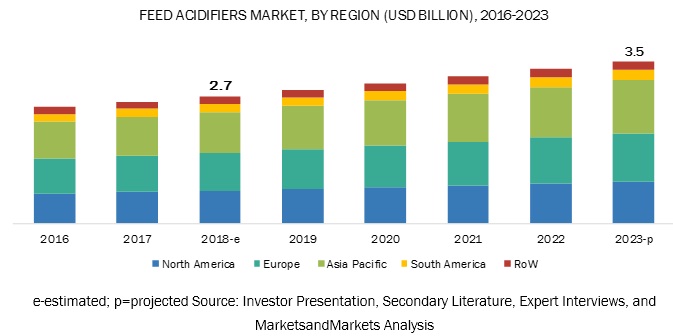The feed acidifiers market is estimated to grow from USD 2.7 billion in 2018 to USD 3.5 billion by 2023, at a CAGR of 5.1% during the forecast period. The major factors driving the feed acidifiers market include the rising consumption of livestock by-products, high threat of diseases in livestock, growing government aids or funds promoting the wellness of the feed industry, and ban of antibiotics in the European Union (EU). The feed acidifiers market is experiencing strong growth due to initiatives being taken for improving animal health globally.

Driver: High threat of diseases in livestock
The outbreak of diseases such as avian flu, BSE (bovine spongiform encephalopathy), and SARS (severe acute respiratory syndrome) not only affect livestock breeding and the economy, but also pose a threat to human health. The emergence of swine diarrhea in the US caused significant losses to swine farmers. Moreover, countries such as China, India, and Indonesia are constantly facing outbreaks of avian flu and swine flu, due to the hot and humid climatic conditions. Meat vendors, meat processors, wholesalers, retailers, and ultimately, livestock growers suffer financial losses due to the culling of disease-affected animals, which further leads to a drop-in animal productivity. The foot and mouth disease (FMD) outbreak in the UK in 2007 led to losses of USD 3.7 billion to the livestock sector. The avian flu outbreak of 2013 resulted in economic losses worth USD 6.1 billion in China. Nearly, 130 people were infected in mainland China during this outbreak, according to the UN. Feed safety has increasingly become a matter of concern for many governments around the world, especially those in North America and Europe. Also, consumers around the world are now more aware and informed and are giving importance to the extrinsic attributes of the meat they consume. Certain pathogenic and parasitic contaminations in meat products—Salmonella, Listeria, and E. coli—could thereby cause various disease outbreaks in livestock animals.
Download PDF Brochure: https://www.marketsandmarkets.com/pdfdownloadNew.asp?id=163262152
Opportunity: Encapsulation techniques being used for feed acidifiers
Feed acidifiers have positive effects on livestock health but are often difficult to properly process in feed. Acidifiers tend to lose their efficacy and efficiency, owing to their vulnerability to high temperatures, dusty environment, significant odors, and other volatile properties. As a result, manufacturers are now coming up with newer technologies that help improve feed efficiency by successfully locking in feed acidifiers along with their relevant efficacies and properties. Encapsulation acts as a novel technology for feed products, especially for acidifiers that allow them to improve their release and enteric action and have a longer shelf-life by protecting them against environmental changes, by keeping the liquid, gaseous, or solid acidifier substance packed in a tiny millimetric capsule. These acidifiers are encapsulated in such a manner that the digestive tract obtains small quantities of various acids in a progressive manner. As a result, the amount of acidifiers released into the stomach remains low while the amount reaching the intestinal tract is higher, thereby improving operating efficiency. Along with this protection against extreme environmental factors, encapsulation also maintains the key properties of acidifiers, such as the enhancement of palatability, stability in ration, improved digestion, and better livestock performance.
The Feed Acidifiers Market To Record the Fastest Growth in South America During the Forecast Period
As governments in the South American region focus on investing in the livestock sector, rearers in various countries of this region are allocating their budget to utilize feed acidifiers. Rearers are mainly focusing on improving the meat quality by utilizing feed acidifiers and offer GRAS-certified produce in the market. The demand for meat and poultry products is also projected to increase in parallel to the population growth and disposable income of consumers in this region. Due to these factors, the market in this region is expected to record the highest growth during the forecast period.
Speak to Analyst: https://www.marketsandmarkets.com/speaktoanalystNew.asp?id=163262152
Leading players in the feed acidifiers market are adopting strategies such as product launches, acquisitions, expansions, and collaborations & divestments. Key players identified in this market include Yara International ASA (Norway), Kemira OYJ (Finland), BASF SE (Germany), Biomin Holding GmbH (Austria), and Kemin Industries Inc., (US).
Overall, the growth of the feed acidifiers market is projected to remain moderate during the forecast period. As the competition to offer effective feed acidifiers intensifies in the market, leading players to focus on expansions and collaborations to enhance their brand presence across regions and expand their customer base. These factors are projected to encourage high growth during the forecast period.
Critical questions the report answers:
- Where will all these developments take the industry in the long term?
- What are the upcoming trends for the feed acidifiers market?
- Which segment provides the most opportunity for growth?
- Who are the leading vendors operating in this market?
- What are the opportunities for new market entrants?
